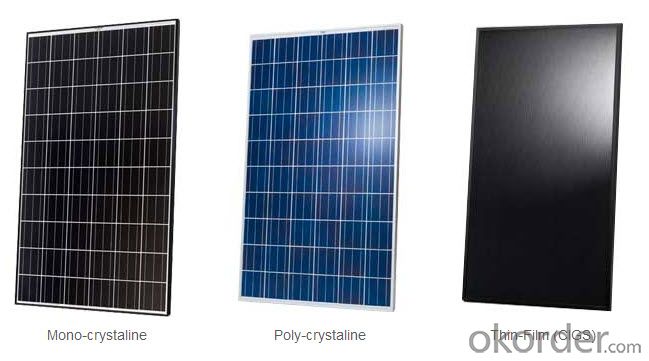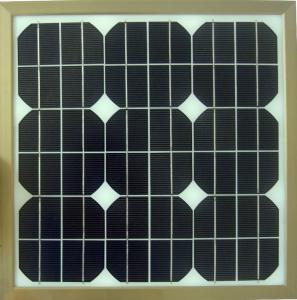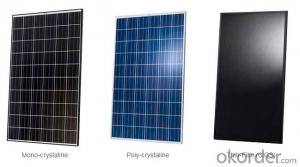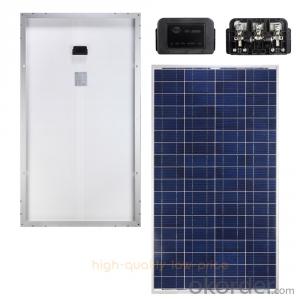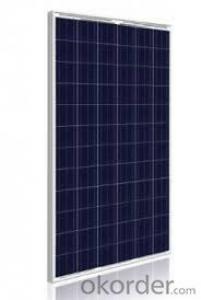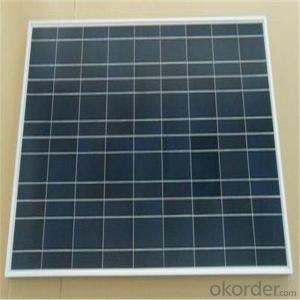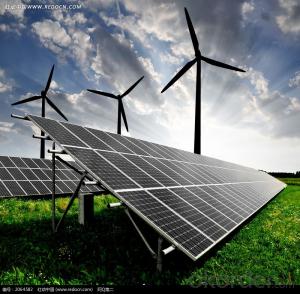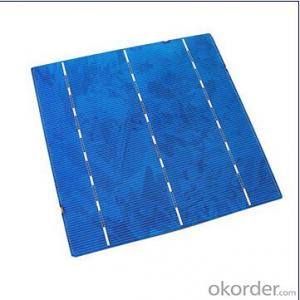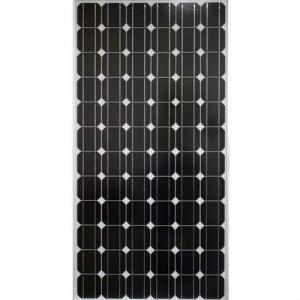Sunpower Solar Cells 235w Poly Solar Panel with 25 Years Warranty CNBM
- Loading Port:
- Qingdao
- Payment Terms:
- TT OR LC
- Min Order Qty:
- 10 set
- Supply Capability:
- 300000 set/month
OKorder Service Pledge
OKorder Financial Service
You Might Also Like
Polycrystalline Solar Modules
CNBM offers a range of small, medium and large polycrystalline solar modules, designed for a range of requirements.
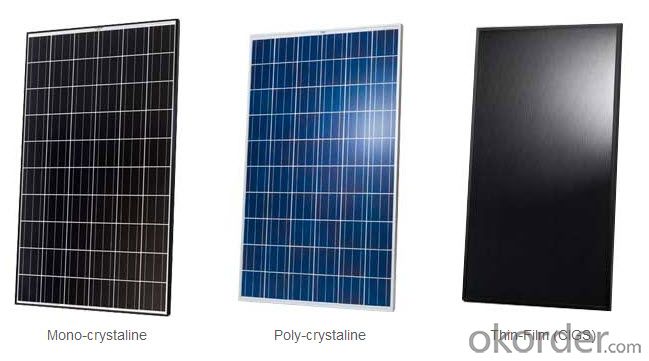

Specifications:
Tolerance | +/-3% |
Cell | Polycrystalline silicon solar cells (156 x 156mm) |
N0. of Cells | 60 (10 x 6) |
Dimension of Modules (mm) | 1650 x 990 x 40 |
Weight (kg) | 25.5 |
Limits:
Operating Temperature | -40~+85? |
Storage Temperature | -40~+85? |
Maximum System Voltage | 1000 VDC max. |
Hail Impact | Diameter of 28mm with impact speed |
Temperature and Coefficients:
NOCT | 48C+/-2? |
Voltage temperature coefficient (%/K) | -0.35 |
Current temperature coefficient (%/K) | 0.05 |
Power temperature coefficient (%/K) | -0.45 |
Characteristics:
Model: | SGM-200P | SGM-210P | SGM-220P |
Max-power voltage Vmp (V) | 29.2 | 29.4 | 29.41 |
Max-power current Imp (A) | 6.85 | 7.14 | 7.48 |
Open-circuit voltage Voc (V) | 36.5 | 36.69 | 36.9 |
Short-Circuit Current Isc (A) | 7.28 | 7.6 | 7.93 |
Max-power Pm(W) | 200 | 210 | 220 |
Model: | SGM-230P |
Max-power voltage Vmp (V) | 29.8 |
Max-power current Imp (A) | 7.72 |
Open-circuit voltage Voc (V) | 37.31 |
Short-Circuit Current Isc (A) | 8.19 |
Max-power Pm(W) | 230 |
STC: Irradiance 1000W/m2, module temperature 25?, AM-=1.5
Poly Crystalline Solar Panels Specifications Range
Maximum Power (Pm) | Dimension | Weight | Operating Voltage (Vmp) | Operating Current (Imp) | Open Circuit Voltage (Voc) | Short Circuit Current (Isc) |
0.45W | 140x80x10mm | 0.08kg | 3.3V | 150mA | 4.6V | 160mA |
1.0W | 162x140x10mm | 0.16kg | 7.5V | 150mA | 10.3V | 160mA |
4.5W | 269x251x23mm | 0.8kg | 16.5V | 0.27A | 20.5V | 0.3A |
10W | 420.1×268.9×22.6mm | 1.92kg | 17.5V | 0.58A | 20.5V | 0.6A |
20W | 425x502x50mm | 3.0kg | 16.8V | 1.19A | 21.0V | 1.29A |
30W | 593x502x22.6mm | 3.9kg | 16.8V | 1.78A | 21.0V | 1.94A |
40W | 655x537x50mm | 5.75kg | 17.3V | 2.31A | 22.1V | 2.54A |
50W | 839x537x50mm | 6.0kg | 17.5V | 2.9A | 21.8V | 3.17A |
65W | 1111x502x50mm | 7.2kg | 17.6V | 3.69A | 22.1V | 3.99A |
80W | 1204x537x50mm | 7.7kg | 17.6V | 4.55A | 22.1V | 4.8A |
- Q: Can solar cells be used in high-altitude areas?
- Yes, solar cells can be used in high-altitude areas. In fact, solar cells can actually be more efficient at higher altitudes due to reduced atmospheric interference and increased solar irradiance. However, the performance of solar cells can still be affected by factors like temperature and snow cover, which need to be considered for optimal utilization in high-altitude regions.
- Q: Are solar cells affected by extreme temperatures?
- Yes, solar cells can be affected by extreme temperatures. High temperatures can cause the efficiency of solar cells to decrease, as excessive heat can cause an increase in resistance and reduce the voltage output. Similarly, extremely cold temperatures can also impact their performance, although to a lesser extent. It is important to note that modern solar cells are designed to withstand a wide range of temperatures, and their efficiency is typically optimized within a specific temperature range.
- Q: Can solar cells be used for powering electric vehicles charging stations?
- Yes, solar cells can be used to power electric vehicle charging stations. Solar panels can generate electricity from sunlight, which can be used to charge electric vehicles. This renewable energy source is clean and sustainable, reducing reliance on fossil fuels and decreasing carbon emissions. Additionally, solar-powered charging stations can be installed in remote locations where grid connection may not be feasible.
- Q: Can solar cells be used to power surveillance cameras?
- Yes, solar cells can be used to power surveillance cameras. Solar cells, also known as photovoltaic cells, convert sunlight into electricity. By installing solar panels and connecting them to surveillance cameras, the cameras can be powered by the generated solar energy, making them independent of traditional power sources. This allows for remote surveillance in areas without access to the electrical grid, increasing flexibility and reducing costs in surveillance systems.
- Q: How do solar cells handle power factor correction?
- Solar cells do not handle power factor correction directly. Power factor correction is typically addressed at the level of the grid or inverter systems that convert the DC power generated by solar cells into AC power for use in homes and businesses. However, advanced inverter technologies used in solar power systems can incorporate power factor correction capabilities to improve the overall efficiency and power quality of the system.
- Q: How do solar cells affect the electric grid?
- Solar cells can have a positive impact on the electric grid by generating clean and renewable energy. When connected to the grid, excess electricity produced by solar cells can be fed back into the grid, reducing the overall demand for electricity. This can help stabilize the grid and decrease the need for traditional fossil fuel-based power plants. Additionally, solar cells can help to decentralize the grid by generating electricity closer to where it is needed, reducing transmission losses and increasing grid resilience.
- Q: Whether the solar cell is light can produce electricity
- A solar cell is a device that converts light energy directly into electrical energy by photoelectric effects or photochemical effects.
- Q: Can solar cells be used in public transportation?
- Yes, solar cells can be used in public transportation. They can be integrated into vehicles such as buses, trams, or trains to harness solar energy and power various onboard systems. Solar panels on the roof can generate electricity to charge batteries, power lighting and ventilation systems, or even propel the vehicle itself. This helps reduce reliance on traditional fuel sources and decreases carbon emissions, making public transportation more sustainable and environmentally friendly.
- Q: What is the impact of wind on solar cell performance?
- The impact of wind on solar cell performance can be both positive and negative. On one hand, wind can help to cool down the solar panels, preventing them from overheating and maintaining their efficiency. Additionally, a gentle breeze can help to disperse any accumulated dust or debris on the panels, ensuring maximum sunlight absorption. On the other hand, strong winds can create vibrations that may damage the solar panels or the mounting structure, leading to potential performance degradation or even system failure. Therefore, while some wind can be beneficial, it is important to properly design and install solar panels to withstand and minimize any negative impact from strong winds.
- Q: How does a solar cell work?
- A solar cell works by converting sunlight into electricity through the photovoltaic effect. It consists of a thin semiconductor material, usually silicon, which absorbs photons from sunlight. When the photons strike the semiconductor material, they transfer their energy to the electrons in the material, causing them to become excited and move freely. This creates a flow of electrons, known as an electric current. The solar cell contains two layers, one with excess electrons (n-type) and the other with a deficiency of electrons (p-type), creating an electric field. As the excited electrons move towards the p-n junction, the electric field forces them to move in one direction, resulting in a usable electric current. This current can be harnessed and used to power various devices or stored in batteries for later use.
Send your message to us
Sunpower Solar Cells 235w Poly Solar Panel with 25 Years Warranty CNBM
- Loading Port:
- Qingdao
- Payment Terms:
- TT OR LC
- Min Order Qty:
- 10 set
- Supply Capability:
- 300000 set/month
OKorder Service Pledge
OKorder Financial Service
Similar products
Hot products
Hot Searches
Related keywords



